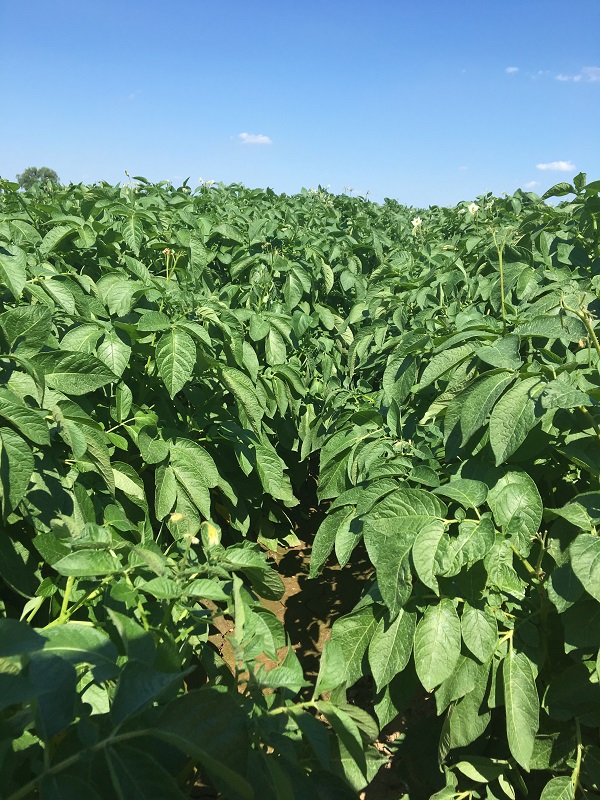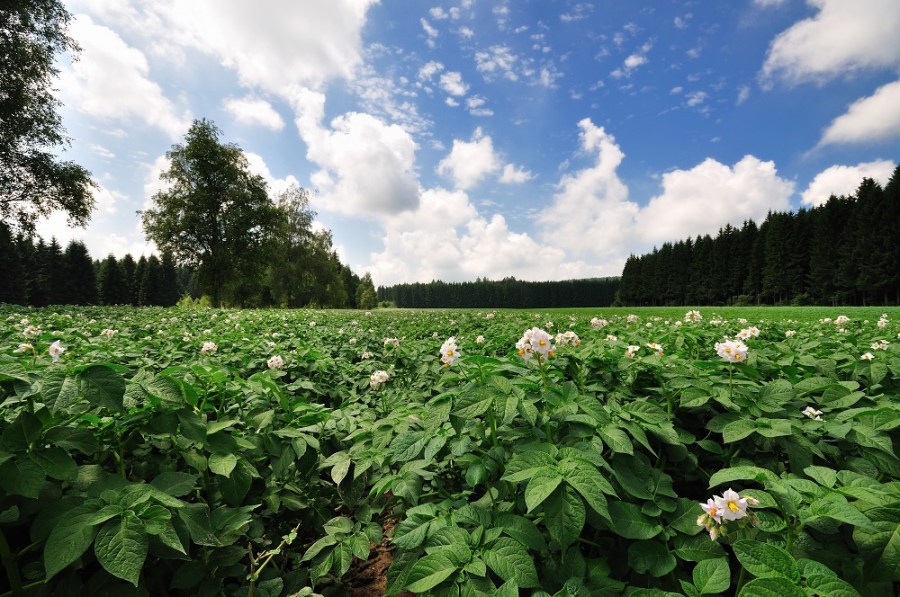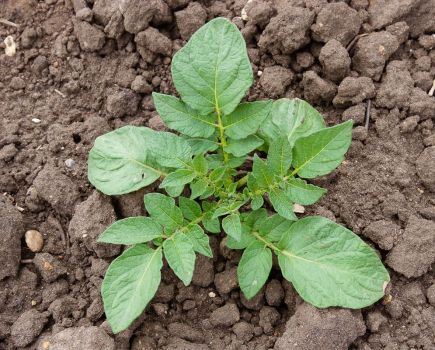With a changing blight population and more aggressive genotypes, getting good fungicide coverage has become even more important. CPM finds out how a drift retardant can help produce a droplet that’s ‘just right’ to get to the hard to reach places within the canopy.
The canopy is formed by a series of interlocking leaves and this makes this even fungicide coverage very difficult.
By Lucy de la Pasture
While much of the discussion surrounding late blight (Phytophthora infestans) concentrates on the selection of active ingredients, the other side of the equation is the application of fungicide. Get either of these wrong and you risk seriously compromising blight control.
But the umbrella-like structure of the potato plant makes a difficult target to attain good fungicide coverage, explains Interagro technical manager Stuart Sutherland, particularly when it comes to getting adequate levels of active ingredient to the lower canopy and stems of plants.
“The canopy is formed by a series of interlocking leaves and this makes this even fungicide coverage very difficult to achieve. Leaves are good collectors of vertical moving spray in the upper canopy, but the leaves and stems lower down can be very hard to reach,” he comments.

The umbrella-like structure of the potato plant makes a difficult target when it comes to achieving good fungicide coverage.
Interagro have engineered a solution to the application problem in their specialist drift-retardant Crusade (or Sterling), which can help growers get the best performance from blight sprays, says Stuart.
The efficiency of blight fungicide Percos (ametoctradin+ dimethomorph) has been so improved by the addition of Crusade that it’s now recommended by its manufacturer, BASF. Independent trial results with SRUC have shown that when the two products are used together, an indirect benefit of the drift retardant is the improved efficacy of Percos above that of the straight product.
The addition of Crusade has also been shown to increase the efficacy of Percos significantly over that of some of the strongest competitor products.
So how does Crusade work to reduce spray drift, increase fungicide coverage and performance? According to Stuart, it creates the ‘Goldilocks droplet’.
“Droplets can’t be too big (bounce off the leaf, miss the target) or too small (evaporate, drift off target), they have to be just right. Crusade creates droplets more capable of reaching the upper and lower canopy.
“Drift is the biggest cause of off-target chemical movement and threatens the crop from disease where it’s not adequately protected. Crusade reduces drift, which in turn ensures the full intended dose is delivered to the whole crop in order to maximise fungicide performance.
“It does this by significantly reducing the number of fine spray droplets smaller than 100 microns (most susceptible to drift) and increases spray angle uniformity at the nozzle, ensuring the correct dose is applied to the target,” he explains.
This ‘Goldilocks effect’ has been studied in detail at Syngenta’s Jealott’s Hill Research Centre. Using laser diffraction particle/droplet size technology, Syngenta application specialist Alan Cochran has shown that by physically altering the properties of individual droplets, Crusade appears to reduce the number of ultra-fine droplets that are most susceptible to drift. But at the same time, it also reduces the number of very coarse droplets that could be more susceptible to bounce or rolling off the leaf.
“It’s believed the action of the drift retardant is likely to coalesce the ultra-fines into small droplets, whilst breaking surface tension to split very coarse droplets into smaller drops. The net effect is to reduce droplet numbers at either end of the spectrum, producing more droplets in the ideal range for potato leaf blight applications.”
The actual result depends on the nozzle being used, but trials indicate that for nozzles which produce a higher proportion of fine droplets, the average droplet size increases. For nozzles which typically create a higher proportion of coarse droplets, the average droplet size decreases.
“In both instances, the proportion of droplets is increased in the ‘optimised’ size range to give a combination of drift reduction and target leaf retention,” comments Alan.
The addition of Crusade to fungicide sprays manipulates droplet size to maximise coverage (and dose) to both the upper and lower canopy. Research at Jealott’s Hill shows that used with Revus (mandipropamid), the proportion of <100µm droplets (the finest drifty droplets) decreases by 47% with the industry standard Syngenta 05 potato nozzle.
At the same time, the volume median diameter (VMD) of droplets – essentially the average droplet size – only increases by 22%, from 277μm with Revus alone to 338μm, thus maintaining good droplet numbers for coverage. That equates to an average 35% improvement in the nozzle’s drift reduction capability, when operated at 2-3 bar, compared to a standard flat fan.
“Equally importantly, the addition of Crusade tightened the relative span of droplet sizes in the spray pattern – creating more droplets in the optimum sizing. With the 05-potato nozzle, the relative span was reduced by 15% when operated at both two bar and three bar pressure,” he adds.
For other nozzles the effects were less marked. With the 05-Amistar nozzle, which already reduces drift risk with its air-induction design, the controlled environment trial shows limited benefit from the addition of Crusade with Revus – just 2% improvement in drift reduction compared with Revus alone.
But with a categorised 90% Drift Reduction Technology Lechler IDTA 05, the addition of Crusade appears to reduce the number of extremely coarse droplets – showing an 11% lower VMD and an 8% tighter relative span – with no negative impact on the drift reduction.
Drift reduction is extremely important with all applications, but it’s even more crucial that operators achieve consistent coverage across leaf surface when it comes to blight protection, highlights Syngenta technical manager Michael Tait.
“You need to get the maximum amount of product onto the crop so it can do the best possible job, while also minimising any loss to the wider environment,” he says.
One of the major issues with drift during application is a gusty wind which moves the spray pattern, even within the width of the spray boom. The consequence is uneven spray deposition, potentially leaving patches under-dosed and more exposed to late blight infection.
Syngenta application trials have shown that on a ‘perfect spray day’, with an average wind speed of 1.2m/s at boom height (2.7mph), the actual wind speed varied from 0.1 to 4.3 m/sec (0.22 to 9.6 mph).
“Potato sprayer operators and agronomists often talk about requiring ‘small’ droplets, to permeate down through the potato crop canopy, and avoiding big heavy droplets that could bounce off the leaf or over wet and run off the canopy surface. But nozzles producing more droplets at the smaller end of the spectrum almost inevitably increase the risk of drift,” he explains.
That begs the question, what defines ‘small’? “In reality, the very small droplets (sub 100 microns) lose virtually all energy and momentum soon after they leave the nozzle tip and are highly susceptible to drift. In many instances they don’t even have sufficient energy to break through the surface tension of an air pocket that sits above the crop canopy, so they can’t reach the leaf surface.”
It’s a problem that can be further exacerbated if the soil or crop is relatively warm compared with the surrounding air temperature. “When rising air creates a thermal inversion it will lift and carry away these very small droplets. This can often be the case when spraying potatoes early in the morning, before the air temperature rises, and is potentially most serious in very still conditions,” explains Michael.
At the other end of the droplet spectrum are large, high-velocity droplets, typically categorised as over 500 microns. “These have the momentum to more easily penetrate deep into the crop but can have a tendency to be intercepted by the top canopy and potentially bounce or roll off the leaf,” he points out.
“Even though potato leaves are relatively large and have a hairy surface, making them easier to wet and better able to retain droplets than an upright leaf such as wheat, when potato leaves are deeper in the canopy, or in higher humidity conditions and after irrigation or rainfall where surfaces are already moist, large droplets can over-wet the leaf to result in run off and less retention.
One of the solutions is to angle the nozzle spray pattern and this has been shown to enable more of the larger droplets to penetrate in under the canopy surface.
“For the 2019 blight season, our application advice would be to use the Syngenta potato nozzle where possible. The addition of Crusade in the tank mix would certainly appear to have a valuable role, which we’ve seen from the Jealott’s Hill nozzle research and maximise the performance of blight control in field trial results.
“For the future, new 90% DRT nozzle designs offer the opportunity to research better targeting of application in the field. If the initial research results showing the effects of drift retardants can maximise the result from blight fungicides, whilst reducing risk of drift, it’s an exciting potential.”
Pay attention to what you can control
Since the blight population started to change dramatically in the mid-2000s, the new genotypes of P. infestans tend to produce sporangia earlier and in greater numbers than most of the displaced genotypes, comments Dr Ruairidh Bain, plant pathologist at SRUC’s Auchincruive Estate in South Ayrshire.
“The newest highly aggressive genotypes 36_A2 and 37_A2 join the aggressive 13_A2 and 6_A1 in being able to rapidly exploit any weaknesses in spray coverage within the canopy,” he says.
“Where coverage isn’t optimal then there tends to be a scattered infection across the crop rather than blight foci. Such scattered infection moves the risk of tuber blight to the whole crop, rather than in defined areas,” he explains.
Ruairidh Bain has been working with Crusade in SRUC’s potato blight trials since 2014 and confirms he’s seen an improvement in efficacy of blight fungicides where the drift-retardant has been included. He remains impressed by results, confirmed again in last year’s trials with Crusade, which were carried out at SRUC for an independent company, under very high blight pressure.
“A key feature of Crusade is the maximisation of blight control with a wide range of different active ingredients,” he comments.
In many regions last season blight wasn’t a threat during the prolonged dry hot summer but for 2019 Ruairidh urges growers to expect the worst and, if things turn out differently, then it’s a bonus.
And by the worst, he also means expect the more aggressive strains even if they haven’t been identified in your region previously, as well as prepare for blight-risk weather closer to normal.
“Last season we inoculated blight trials at SRUC with 13_A2, using just one blight genotype so that we got uniform blight pressure across the trials. At the end of the season we frequently find genotypes which we didn’t introduce and last year we picked up 37_A2 (confirmed by David Cooke, JHI), which hasn’t been detected north of the border before.
“So where genotypes are concerned, it’s a case of anything can happen so don’t assume the newest, most aggressive blight strain, 36_A2, is confined to southern and eastern parts of the UK,” he says.
Given the difficulty in predicting in April either the severity of the season’s epidemic or the genotypes that will be responsible locally, Ruairidh suggests growers pay close attention to the factors that are in their control, namely selecting the appropriate active ingredients and achieving good fungicide coverage.
He warns growers to avoid fluazinam for control of blight because the 37_A2 genotype has developed resistance. If it has to be used for sclerotinia control, he advocates using it with a full-rate blight spray with a different mode of action.
Modern blight strategies must have an emphasis on fungicide resistance management, he believes. “That means alternating modes of action and mixing products with different modes of action to make sure there is no selection pressure in any particular direction for any more than seven days at any one time.
“Keep spray intervals short and if conditions become less risky, like last season, then don’t stretch intervals but you can use cheaper active ingredients to reduce cost.”
Pushing performance
At the heart of good crop production lies careful use of chemistry to protect the plant and maintain performance, right through the season. But optimising the efficacy of plant protection products can be challenging, while increasingly restrictive regulations limit just how far you can go.
This series of articles explores the science behind the use of adjuvant and biostimulant tools to help power both chemistry and crop performance, as well as increase understanding of why they’re needed and what they do. We’re setting out to empower growers and drive crops to reach their full potential.
CPM would like to thank Interagro for kindly sponsoring this article, and for providing privileged access to staff and material used to help put the article together.
Crusade is a flexible anti-drift agent specifically designed for use with all potato blight fungicides to reduce drift and maximise coverage to all parts of the crop.




